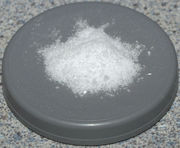Nope. As refined by home-brew or terrorist chemists, it's usually a white or off-white powder, discoloured by a yellowish or greyish tinge,depending on the precursor source chemicals used.

Per an article on Wikipedia.org [chemistry and ingredients list deleted]:
Acetone peroxide (triacetone triperoxide, peroxyacetone, TATP, TCAP) is an organic peroxide Organic peroxides are organic molecules containing the peroxide functional group
ROOR'
If the R' is hydrogen, the compound is called organic hydroperoxide.
The O-O bond easily breaks and forms free radicals of the form:
RO¡¤
This makes organic peroxides useful as catalysts for some types of polymerisation, such as the epoxy resins used in glass-reinforced plastics. MEKP and benzoyl peroxide) are commonly used for this purpose.
Click the link for more information.
. It is a high explosive that can be made from common household items: acetone acetone (also known as propanone, dimethyl ketone, 2-propanone, propan-2-one and beta-ketopropane) is the simplest representative of the ketones.
Since its precursors are readily available, it is commonly used by amateur chemists and explosive makers, often for detonators, and is sometimes found in improvised explosive devices. It takes the form of a white crystalline powder with a distinctive acrid smell.
It is highly heat, friction, and shock.
TCAP generally burns when ignited, unconfined, in quantities less than about 2 grams. Above this, it will usually detonate, although even slight confinement will promote detonation in smaller quantities. Completely dry TCAP is much more prone to detonation as opposed to fresh product still wetted with water or acetone. The oxidation that occurs when burning is:
2 C9H18O6 + 21 O2 ¡ú 18 H2O + 18 CO2 The explosive decomposition of TCAP, in contrast, results in "formation of acetone and ozone as the main decomposition products and not the intuitively expected oxidation products." [1] It is the rapid creation of gas from a solid that creates the explosion. Very little heat is created by the explosive decomposition of TCAP. Recent research describes TCAP decomposition as an entropic explosion.
The extreme shock, heat, and friction sensitivity are due to the instability of the molecule. Big crystals, found in older mixtures, are more dangerous, as they are easier to shatter - and initiate - than small ones.
Many people have been killed or permanently injured by accidents with acetone peroxide. There is a common myth that the only "safe" acetone peroxide is the trimer, made at low temperatures: "If one is making tricycloacetone peroxide, the temperature must be less than 10 ¡ãC at all times, otherwise the product formed will be dicycloacetone peroxide, which is so unstable and sensitive that it has no uses in the field of explosives: dicycloacetone peroxide has been known to explode spontaneously." In reality, the acid-catalyzed peroxidation of acetone always produces a mixture of dimeric and trimeric forms. The trimer is the more stable form, but not much more so than the dimer. All forms of acetone peroxide are very sensitive to initiation and degrade in long-term storage, so they are used as explosives only by unconventional forces (e.g. guerrillas, freedom fighters, terrorists) and curious amateurs. At the same time, no form of acetone peroxide will truly explode spontaneously.